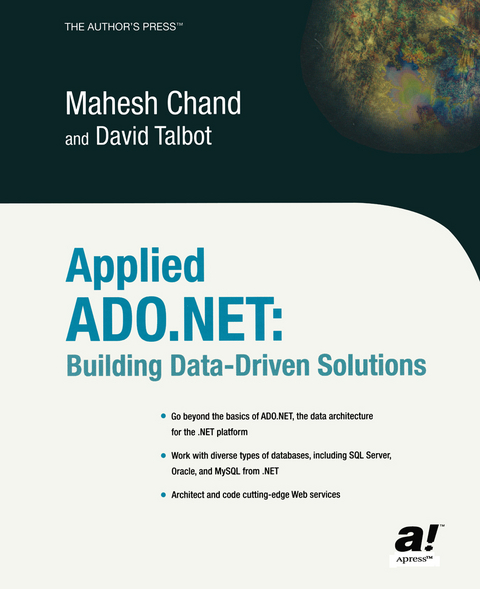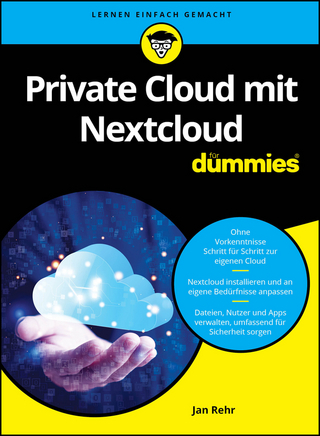
Applied ADO.NET
Apress (Verlag)
978-1-59059-073-7 (ISBN)
Applied ADO.NET: Building Data-Driven Solutions provides extensive coverage of ADO.NET technology, including ADO.NET internals, namespaces, classes, and interfaces. Whereas most books cover only the SQL and OLE DB data providers, authors Mahesh Chand and David Talbot detail the SQL, OLE DB, and ODBC data providers, as well as additions to ADO.NET, the Oracle, MySQL, and XML .NET data providers. Chand and Talbot also cover the internals of data binding and provide detailed coverage of both Windows Forms and Web Forms data binding and data-bound controls. Because XML plays a major role in .NET development, the authors take a comprehensive look at XML namespaces and classes, and how to integrate both with ADO.NET.
The book begins with the basics of ASP.NET and data-bound controls. It then delves into the internals of data binding and shows how to use DataGrid, DataList, and other data-bound controls in real-world applications. Chand and Talbot also discuss the ASP.NET guest book, database XML Web services, and even an online bookstore site development and design process.
The book also covers
How to create a custom data provider
Event handling
Server-side programming
Data relations and constraints
Active Directory
Messaging
Exception and error handling
The object relational model
Advanced developers will learn from the coverage of ADO.NET architecture, related design issues, and how ADO.NET data providers are designed.
David Talbot's background is diverse, ranging from developing license-plate recognition technology to television-set boxes to scalable web applications. Currently, David works in the new business technologies group at FreeMarkets, applying cutting-edge .NET technologies to solve business problems. He has been working with .NET since the early betas, developing a number of solutions for a number of start-ups and established companies while working on several .NET books and articles. Prior to the development of .NET, David worked primarily on Java, SCO UNIX, Linux, DB2, SQL Server, and Perl.
1 ADO.NET Basics.- 2 Data Components in Visual Studio .NET.- 3 ADO.NET in Disconnected Environments.- 4 ADO.NET in Connected Environments.- 5 Handling ADO.NET Events.- 6 Integrating XML with ADO.NET.- 7 Data Binding and Windows Forms Data-Bound Controls.- 8 Constraints and Data Relations.- 9 ADO.NET Exception Handling.- 10 Working with the ODBC .NET Data Provider.- 11 Stored Procedures and Views.- 12 Oracle, SQLXML, and Other .NET Data Providers.- 13 Developing a Custom Data Provider.- 14 Developing Database Web Applications Using ASP.NET.- 15 Using ADO.NET in XML Web Services.- 16 ASP.NET Server Controls and Data Binding.- 17 Building Real-World Web Applications.- 18 Object-Relational Mapping in .NET.- 19 Mapped Objects: Performance Considerations and Data Binding.- 20 COM Interoperability and ADO.NET.- 21 Messaging.- 22 SQL Server and ADO.NET: Notes on Performance.- Appendix A Relational Databases: Some Basic Concepts.- Understanding Normalization.- First Normal Form (1NF).- Second Normal Form (2NF).- Third Normal Form (3NF).- Boyce-Codd Normal Form (BCNF).- Fourth Normal Form (4NF).- Fifth Normal Form (5NF or PJ/NF).- Introducing Sets, Cursors, and ADO.NET.- Using Locking.- Isolation Levels.- Locking Modes.- Summary.- Appendix B Commonly Used SQL Statements.- Understanding SQL References.- Using the SELECT Statement.- Using the UPDATE Statement.- Using the DELETE Statement.- Using the CREATE TABLE Statement.- Using the DROP TABLE Statement.- Using the TRUNCATE TABLE Statement.- Using the INSERT Statement.- Using Joins and Aliases.- Understanding Views.- Using SQL Server’s SELECT...FOR XML Clause.- Summary.- Appendix C ADO.NET Frequently Asked Questions.- Summary.
| Erscheint lt. Verlag | 1.4.2003 |
|---|---|
| Zusatzinfo | XXXIV, 928 p. |
| Verlagsort | Berkley |
| Sprache | englisch |
| Maße | 178 x 235 mm |
| Themenwelt | Mathematik / Informatik ► Informatik ► Betriebssysteme / Server |
| Mathematik / Informatik ► Informatik ► Datenbanken | |
| Mathematik / Informatik ► Informatik ► Programmiersprachen / -werkzeuge | |
| Mathematik / Informatik ► Informatik ► Software Entwicklung | |
| ISBN-10 | 1-59059-073-2 / 1590590732 |
| ISBN-13 | 978-1-59059-073-7 / 9781590590737 |
| Zustand | Neuware |
| Haben Sie eine Frage zum Produkt? |
aus dem Bereich


